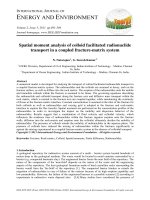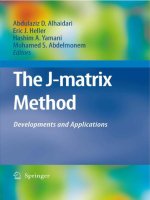C7 matrix acidizing
Bạn đang xem bản rút gọn của tài liệu. Xem và tải ngay bản đầy đủ của tài liệu tại đây (2.72 MB, 73 trang )
Designed & Presented by
Mr. ĐỖ QUANG KHÁNH, HCMUT
03/2014
Đỗ Quang Khánh – HoChiMinh City University of Technology
Email: or
1
Content & Agenda
Introduction
Used acidic solutions in matrix acidizing
Basic properties of acid-mineral interactions
Candidate selection
Treatment type selection
Sandstone acidizing design-typical acidizing formulations for sandstone formations
Carbonate acidizing design
Ref:
Reservoir Stimulation, 3e – Economides & Nolte
Petroleum Production Systems - Economides et al., 1994
Production Operations: Well Completions, Workover, and Stimulation -Thomas O. Allen,
Alan P. Roberts,1984
Introduction
o Matrix stimulation is a technique in which a solvent is injected into the formation to dissolve some of
the materials present and hence recover or increase the permeability in the near-wellbore region.
Such treatments are called “matrix” treatments because the solvent is injected at pressures below
the parting pressure of the formation so that fractures are not created. The objective is to greatly
enhance or recover the permeability near the wellbore, rather than affect a large portion of the
reservoir.
o The most common matrix stimulation treatment is acidizing, in which an acidic solution is injected to
dissolve minerals in the formation. However, other solvents are also used. The next most common
fluids onversare organic solvents aimed at dissolving waxes, paraffins, asphaltenes or other organic
damaging materials.
o (Matrix) acidizing is a near-wellbore treatment, with all the acid reacting within
o about 1 ft of the wellbore in sandstone formations and
o a few inches to perhaps as much as 10 ft from the wellbore in carbonates.
Introduction
o Matrix acidizing can significantly enhance the productivity of a well when near-wellbore formation
damage is present and, conversely, is of limited benefit in an undamaged well.
o The goal of a matrix acidizing treatment is to reduce the non-mechanical skin effect to near zero.
o Main applications for matrix acidizing:
o only when a well has a high skin factor that cannot be attributed to partial penetration, perforation efficiency or other mechanical
aspects of the completion.
o in highly productive wells, the productivity improvement of about 20% that is possible with matrix stimulation of an undamaged
well may be economic.
o in naturally fractured or highly vugular carbonate reservoirs, live acid may penetrate to a sufficient distance to yield a productivity
enhancement greater than that normally expected from a true matrix treatment.
o High permeability formation with damage
o Formations not suitable for fracturing
o
Water/Gas Cap near oil zone
o
Mechanical treating limitations
o To Supplement Fracturing
Introduction
o An ideal matrix treatment restores the permeability in the near-wellbore region to a value at least as high
as the original undamaged permeability; it accomplishes this over the entire completed interval and it
leaves the formation in the treated region with high relative permeability to the oil and/or gas phase.
o Designing a treatment should strive to achieve this ideal at the lowest possible cost, which requires
consideration of the many physical and chemical interactions taking place between the injected fluids
and the reservoir minerals and fluids.
mass transfer of acid molecules to the mineral surface and subsequent reaction at the surface
changing pore structure
precipitation of reaction products
acid fluid–reservoir fluid interactions
variations in reservoir permeability or the distribution of damage
USED ACIDIC SOLUTION IN MATRIX ACIDIZING
o Hydrochloric Acid (HCl)
o Organic Acids
o Acetic acid (CH3COOH)
o Formic acid (HCOOH)
o Mud Acid (HCl/HF)
Hydrochloric Acid (HCl)
Organic Acids
Mud Acid
Mud Acid
Mud Acid
o The clays, micas, etc. dissolved by mud acid undergo a series of reactions resulting in precipation of
silica gel (Si(OH 4) – a hydrated form of silica.
BASIS PROPERTIES OF ACID-MINERAL INTERACTIONS
o Acid-mineral reaction stoichiometry
o Acid-mineral reaction kinetics
o Precipitation of reaction products
Acid-mineral reaction stoichiometry
Chemistry
o Minerals present in sandstone pores include
o Montmorillonite (Bentonite) , Kaolinite, Calcite, Dolomite, Siderite, Quartz, Albite (Sodium Feldspar), Orthoclase, and others…..
o Mineral origin from invasion of drill, cementing or completion fluids, or host materials occurring naturally
in the rock formation
o Most commonly used acids to dissolve these minerals: hydrochloric acid (HCl) and hydrofluoric acid (HF)
o Silicate materials (such as clays and feldspars) in sandstone pores normally removed using mixtures of
HCl and HF acid
o Carbonate materials usually addressed by HCl alone
Acid-mineral reaction stoichiometry
Primary chemical reactions in acidizing.
Acid-mineral reaction stoichiometry
The stoichiometry of chemical reaction: the number of moles of each species involved in the reation.
Dissolving power of acids: the amount of mineral that can be consumed by a given amount of acid on a
mass or volume basis.
Acid-mineral reaction stoichiometry
Ex: Calculate the Gravimetric and Volumetric dissolving power of 15% Hydrochloric acid with Calcium
carbonate with ρ acid = 0.0654 lb/ft3 , ρ CaCO3= 0.17 lb/ft3
Sol: •
β 15 = 0.15 x 1 x 100.1 / (2 x(36.5)) = 0.206 lb m CaCO 3 / lb m 15 wt% HCl solution
• X 15 = 0.206 x 0.0654 / 0.17= 0.08 cuft CaCO 3 / cuft 15 wt% HCl solution
Acid-mineral reaction stoichiometry
Ex: A sandstone formation with a porosity of 0.2 contains 5-vol% albite (sodium feldspar). What is the
minimum volume of 3% HF solution required to dissolve all the albite a distance of 6 in. beyond a 6-in.
diameter wellbore?
Sol:
Ex: What is the minimum volume of 15% HCl required to dissolve calcite up to 1ft deep in the reservoir
– Reservoir porosity 18%
– Formation HCl solubility of 10% (Assume all Calcite)
– Wellbore radius 0.3 ft
Sol:
Acid-mineral reaction kinetics
Reaction rate
o The reaction between an acid and a mineral occurs when acid reaches the surface of the mineral by
diffusion or convection from the bulk solution.
o The overall rate of acid consumption or mineral dissolution depends on two distinct phenomena:
o the rate of transport of acid to the mineral surface by diffusion or convection, and
o the actual reaction rate on the mineral surface.
o Usually, one of these processes is much slower than the other. In this case,
o the fast process can be ignored,because it can be thought of as occurring in an insignificant amount of time compared with the
slow process.
Acid reaction occurring in a system
Acid-mineral reaction kinetics
Reaction kinetics
o Kinetics of a reaction is a description of the rate at which the chemical reaction takes place, once the
reacting species have been brought into contact; driven by reactivity of the mineral per unit of surface
area.
o Generally:
- HCl / Carbonate reactions can be considered almost instantaneous, and limited by mass transport
- Most HF-Mineral reactions are slow compared to mass transport rates so overall acid consumption
limited by reaction rate
o Clays will react with HF approx. 2 orders of magnitude faster than silica due to far greater surface area / volume
o Felspars will react with HF approx 1 order of magnitude faster than silica due to greater reactivity
Precipitation of reaction products
o A major concern in acidizing, particularly the acidizing of sandstones, is damage caused by the
precipitation of acid-mineral reaction products. In acidizing sandstones with HF, the formation of some
precipitates is probably unavoidable. However, the amount of damage they cause to the well productivity
depends on the amount and location of the precipitates. These factors can be controlled to some extent
with proper job design.
o The most common damaging precipitates that may occur in sandstone acidizing are :
o calcium fluoride (CaF 2 ),
o colloidal silica (Si(OH) 4 ),
o ferric hydroxide (Fe(OH) 3 ), and
o asphaltene sludges.
o The tendency for precipitation reactions to occur in acidizing is predicted with comprehensive
geochemical models of the chemical reactions between aqueous species and the host of minerals
present.
Precipitation of reaction products
o The most common type of geochemical model used to study sandstone acidizing is the local equilibrium
model, such as described by Walsh et al. (1982) and Faber et al. (1994).
o assumes that all reactions are in local equilibrium; i.e., all reaction rates are infinitely fast.
o a time-distance diagram for the injection of 11% HCl–4% HF into a formation containing calcite, kaolinite and quartz. This plot
shows regions where amorphous silica and aluminum fluoride will tend to precipitate.
o A vertical line on the plot represents the mineral species present as a function of distance if all reactions are in local equilibrium.
o By coupling this model with a model of the formation per meability response to both dissolution and precipitation, predictions of
the productivity improvement expected from particular acid formulations may be obtained
Precipitation of reaction products
o Recently, Sevougian et al. (1992) and Quinn (1994) presented a geochemical model that includes
kinetics for both dissolution and precipitation reactions. This model predicts
o less permeability damage than a local equilibrium model because the finite rate of the reactions allows displacing the pre cipitate
farther from the wellbore.
Candidate Selection
Candidate Selection (Recognition) is the process of identifying and selecting wells for
treatment which have the capacity for higher production and better economic return.
“Good Wells Make the Best Candidates for Well Stimulation”
1. It must have production potential impaired by damage
2. That damage must be treatable through acidizing
3. The NPV of treating with acid should be more attractive than other possible treatments
4. Must be sufficient capacity downstream of the sandface to accommodate expected incr. production
Candidate selection process
o • Review numerous wells.
o • Review of well logs/records, reservoir characteristics and information on the completion/previous workovers.
o • Map the productivity of each well.
o • Establish reasonable upper production potential for fracturing and matrix stimulation techniques.
o • Evaluate potential mechanical problems.
o • Focus on wells with the highest reward and lowest risk.
CANDIDATE SELECTION
Typical screening criteria
o It’s all about the size of the prize
TREATMENT TYPE SELECTION
The chosen chemical treatment fluid should be targeted at the particular type
and location of the formation damage to be removed or treated.
The formation damage/impairment may be related to:
(i) drilling, completion or workover operations,
(ii) produced or (continually) injected fluids,
(iii) injected fluids during specific well operations e.g. well killing.
Chemical treatment types








![Matrix quantum mechanics and 2 d string theory [thesis] s alexandrov](https://media.store123doc.com/images/document/14/rc/ya/medium_8kAdgQLKd0.jpg)
